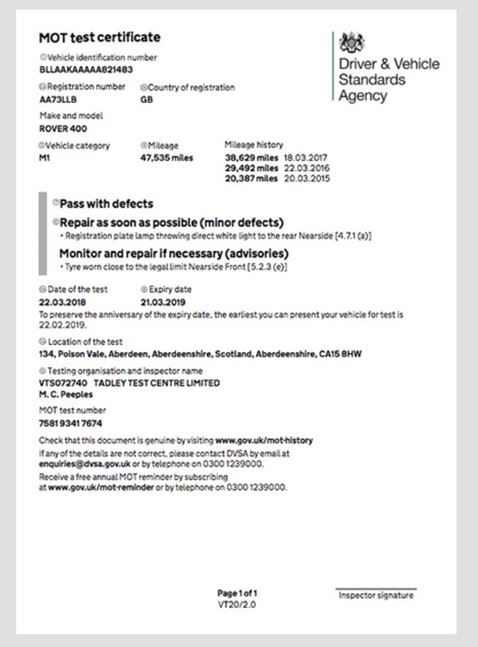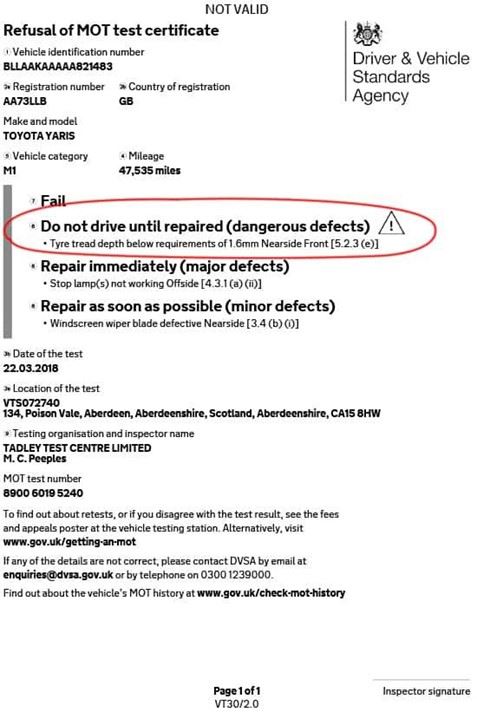The Motorcycle MOT Test: What you need to know - Part Two

THE MOTORCYCLE MOT TEST: WHAT YOU NEED TO KNOW – PART TWO

The MOT test concentrates on legal, environmental and safety issues. A valid MOT certificate is a legal requirement for all motorcycles that are three or more years old and used on the road, with the exception of those that are more than 40 years old and to which no substantial changes have been made in the last 30 years. The certificate is valid for one year. A test taken up to 1 month in advance of the current MOT expiry date will keep the same expiry date. A test taken more than 1 month in advance of the current MOT expiry date will be given a new expiry date one year from the date the test is passed.
In part one of our two-part feature on the MOT test we explain how defects are categorised, what those categories mean, and how modified and crashed/damaged/repaired bikes are treated. Here in part two, we look at what happens during the test itself.
BEFORE THE TEST:
Before attending the test make sure you go over the bike yourself and check items such as the lighting, indicators, horn, tyres etc that can be easily checked. It is crazy to turn up for an MOT and fail on a blown bulb or a bald tyre when that is something you could have dealt with beforehand.

Before the test itself the MOT tester should carry out a general appraisal of the bike, and following this can refuse to test the bike for the following reasons:
- The logbook/registration certificate or other evidence of the date of first use is not shown, and if it or the date of manufacture cannot be determined by other means. This date is important as it determines the test criteria that need to be applied.
- The bike does not have a registration plate, VIN plate, or frame number that identifies the bike, or if any identification marks are unable to be read.
- The bike or any part of it is so dirty that it makes examination unreasonably difficult.
- Any load or luggage prevents the test from being carried out unless it can be removed, or any load or luggage is insecure and prevents the test from being carried out unless it can be removed.
- The tester asks for the fee to be paid in advance and this is not done.
- The bike is emitting substantial quantities of smoke.
- Any cover or fuel cap that needs to be opened and that should open cannot be opened.
- The condition of the bike is such that doing the test means there is a possibility of injury or danger to any person or of damage to the bike or other property.
- The bike is not of a class that the tester is authorised to test, or if the size, weight or configuration of the bike is such that it cannot be tested properly or safely with the facilities available, or if the frame is stamped ‘not for road use’ or words to that effect.
An MOT tester can refuse to complete a test if It becomes apparent during the test that any of the above reasons apply.
An MOT tester has the right to carry out a test ride if he deems it necessary to confirm any aspect of the test and can refuse to complete a test if the bike cannot be ridden because of a lack of fuel or oil, or for any other reason.
THE TEST:
The following areas are looked at and checked:
1: REGISTRATION PLATE AND VEHICLE IDENTIFICATION:
What is checked: The registration plate is the correct size and can be clearly read.
The frame and VIN numbers are present and can be read.
The registration plate and identification numbers match the document presented.
The mileage.
What is checked: The condition of the lights.
All the lights work correctly.
The lights are securely mounted.
The headlight(s) is/are the correct colour.
The headlight beam height is correct.
The indicators work correctly on each side.
A separate rear reflector is fitted.
A working number plate light is fitted, or the plate is correctly illuminated by the taillight.
3: HORN:
What is checked: The horn works and is loud enough.
The horn is suitable for the bike.
4: THROTTLE:
What is checked: The throttle works correctly.
What is checked: The lever works correctly.
The lever isn’t bent, damaged or shortened such that its use is affected.
6: STEERING:
What is checked: The condition of the steering.
The handlebars are securely mounted.
The steering turns smoothly and freely from lock-to-lock.
The steering head bearings are not loose or tight.
What is checked: The condition of the suspension.
The suspension and damping work correctly.
The forks are securely mounted.
The shock absorber(s), linkage if fitted, and swingarm are securely mounted.
What is checked: The condition of the brake components and hoses.
The brakes operate correctly.
The brakes pass the performance test.
The brake lever and pedal function correctly.
What is checked: The condition of the wheels and tyres.
The wheels are secure.
The wheels spin freely.
The front and rear tyres are compatible with each other.
The tyres are suitable for the bike and are correctly fitted.
The tyres have adequate tread.
The tyre valves are in good condition.
What is checked: The chain isn’t too loose or too tight.
The chain isn’t excessively worn.
The sprockets aren’t excessively worn.
A chainguard is fitted and is secure.
11: WHEEL ALIGNMENT:
What is checked: The front and rear wheels are in alignment.
12: FRAME:
What is checked: There are no cracks.
There is no damage.
There is no distortion.
There is no corrosion that could affect the brakes, steering or suspension.
What is checked: The exhaust system is complete.
The exhaust system is secure.
The exhaust isn’t too loud.
14: FUEL SYSTEM:
What is checked: The fuel system components are secure.
There are no fuel leaks.
What is checked: There is a seat.
The seat is secure.
16: FOOTRESTS:
What is checked: There are footrests.
The footrests are secure and can pivot freely.
The test should be carried out in accordance with government guidelines as follows, though the actual order in which things are inspected may vary according to the tester.

NOTE: Full details of inspection processes, criteria and rules are available at: https://www.gov.uk/guidance/mot-inspection-manual-for-motorcycles.
IF YOUR BIKE PASSES

If your bike passes the MOT test you will get a new MOT certificate, valid for one year from the date of expiry of the old certificate if the test is taken up to 1 month before that date, or valid for one year from the date of the test if it is taken more than 1 month before the date of expiry of the old certificate. The new certificate will be recorded in the MOT database.
If the new certificate lists minor defects or advisory notes these should be addressed before the next MOT is due, but there is no legal requirement to do so.
IF YOUR BIKE FAILS

If your bike fails the MOT test because there are major and/or dangerous defects you will get a refusal of MOT certificate notice, and this will be recorded in the MOT database.
You can ride the bike away from the test centre if your current MOT is still valid and no dangerous defects have been listed.
WARNING: YOU CAN BE FINED UP TO £2,500, BE BANNED FROM RIDING AND GET 3 PENALTY POINTS FOR RIDING A BIKE WITH DEFECTS CATEGORISED AS DANGEROUS.
If the refusal notice lists minor defects or advisory notes these should be addressed before the next MOT is due, but there is no legal requirement to do so.
REPAIRING AND RETESTING:
In the following cases you can have a partial retest for free or for a reduced fee:
If you leave the bike at the test centre for repair and it is partially retested within 10 days there is no fee.
If you take the bike away for repair and return it the next day for a partial retest on certain items there is no fee.
If you take the bike away for repair and it is partially retested within 10 days there is a reduced fee.
In all other cases, you will need a full retest and you will have to pay the full fee.
During a partial retest, the following will be checked:
All the previously failed items.
Any items affected by any repairs.
Any minor defects and/or advisories.
